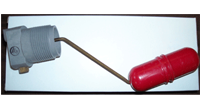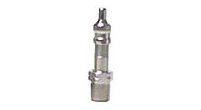Pump Accessories
TORQUE ARRESTOR

Many wells are encased in steel. Many times, especially in older wells, the sides of the well are not straight and sometimes have jagged edges. This usually results in your pump equipment slapping or banging against the sides of the well. Torque arrestors act as a centering device to protect your pump and equipment. They center your pump, pipe and wires in the well, preventing them from damage. The manufacturer recommend installing a torque arrestor for every 200-feet in a residential well. Of course a more efficient option would be to install a constant pressure pump which eliminates high torque and energy consumption.
LIQUID FILLED PRESSURE GAUGE

Gauges are essential for your water pump system. The two types of gauges available are dry and liquid- filled gauges. Dry gauges are less expensive, but do require frequent replacement and sometimes are not as accurate as a liquid-filled gauge. Liquid-filled pressure gauges are filled with liquid glycerin. This serves two purposes. First, the liquid glycerin protects the gauge from freezing during the winter. The glycerin inside the liquid-filled pressure gauge also acts as a cushion for the delicate needle inside the gauge. An investment in a liquid-filled pressure gauge helps ensure less down time because of a faulty gauge.
AIR VOLUME CONTROL

Galvanized water pressure tanks do not use an internal rubber bladder. Over time, the air inside the tank is absorbed into the water. This is referred to the tank being waterlogged. For this reason, galvanized water tanks require an air volume control, snifter valve and bleeder valve. The air volume control valve releases the excess air from the galvanized pressure tank. This helps prevent loss in water pressure and preventing the tank from becoming airlogged.
SNIFTER VALVE

As well as allowing air to escape, sometimes it is necessary to inject air into a galvanized tank. The component necessary to inject air is the snifter valve. Bladder tanks have a snifter valve that has a cap and looks similar to a bicycle tire valve. The snifter valve on a glavanized tank without a bladder works in the same way except that it does not have a cap. The snifter valve allows air to enter the water supply line as necessary. When the water pump shuts off, the snifter valve sucks in air to enter the pipe line to maintain pressure.
PRESSURE RELIEF VALVE

A pressure relief valve removes excess pressure from the galvanized tank. All systems should have a pressure relief valve. The pressure relief valve is a safety mechanism that prevents the water supply line or the tank from exploding due to extreme pressure, much like the pressure relief valve on a hot water tank. When the pressure inside the tank reaches a per-determined pressure point, the pressurize relief valve opens and releases the excess pressure.
PRESSURE SWITCHES

The pressure switch turns the water pump on when the pressure falls below the pre-determined operational pressure setting. Some pressure switches are electronically controlled and connect directly to the water pump. There are also switches that operate in conjunction with a relay.
The most widely sold pressure switches on the market today is the FSG2 Square D Pumptrol pressure switch. It is rated for up to 1 ½ horsepower pumps at 115-volts or 2 horsepower pumps at 230-volts.








